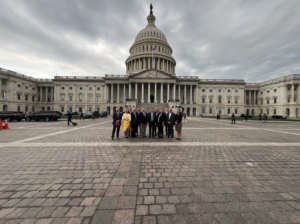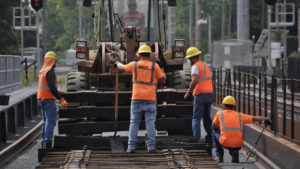N.J. says onus for rail funding rests on Pennsylvania
Written by jroodYou still can't get there from here. While work has gotten under way on an initial seven-mile stretch of route in New Jersey, much more money and political effort are needed to restore passenger rail service from Northeast Pennsylvania to New York City's doorstep - and the onus may fall largely on the Keystone State, the Scranton, Pa., Times-Tribune reports.
"The ball is in
Pennsylvania’s court," said Penny Bassett Hackett, a New Jersey Transit
spokeswoman. "We don’t have a role at this point."
Advocates of the plan to
restore service over the former Lackawanna Cut-Off rail route, meanwhile,
remain unbowed despite the latest setback in their efforts to secure federal
funds.
The long-suffering
project was denied another shot at government money two weeks ago, when the
U.S. Department of Transportation announced Pennsylvania’s application for $401
million in American Recovery and Reinvestment Act funds, under a high-speed
intercity passenger rail program, had failed.
Members of the area’s
congressional delegation say they will pursue other avenues – possibly through
a second round of appropriations in the spring, when the Federal Railroad
Administration expects to solicit applications for $2.5 billion in high-speed
rail money.
After the federal agency
announced funding would not be awarded to the cut-off project, Democratic U.S.
Sens. Bob Casey and Arlen Specter, and U.S. Reps. Paul Kanjorski, D-11,
Nanticoke, and Tim Holden, D-17, St. Clair, met with U.S. Transportation
Secretary Ray LaHood.
"There obviously is
a great deal to be done to move toward total funding, but last week’s meeting
was a productive discussion and a good step along the way," Specter said.
According to a spokesman
for LaHood, the transportation secretary and legislators assessed the
application as part of a "general overview" and looked at ways to
move forward to secure future high-speed rail funding.
Legislators expect to
meet with federal transportation officials again this week or next, Malski
added.
A decade after officials
introduced plans to revive passenger rail service from Scranton to Hoboken,
N.J., full funding for the essential Lackawanna Cut-Off project – a rail-less
stretch of right of way in New Jersey – has yet to materialize, even as New
Jersey has begun work on a seven-mile segment of the 28-mile cutoff. It takes
its name from the Delaware, Lackawanna and Western Railroad, which once
operated the line.
Passenger service ended
in 1970, and freight service over the cutoff died within a decade. Despite
objections from regional leaders, then-owner Conrail tore up the tracks and
sold the right-of-way in the 1980s. New Jersey and Pennsylvania later bought
back the cutoff route with an eye toward ultimately restoring the missing link
between Scranton and metro New York.
Today, the Pennsylvania
Northeast Regional Railroad Authority owns about 60 miles of rail from Scranton
to the Delaware Water Gap, where the tracks end. There begins the 28-mile gap
to Port Morris, N.J., where New Jersey Transit’s 45-mile line from Hoboken
ends. The total trip from Scranton to Hoboken would be 133 miles. From there,
riders could transfer to existing rail, bus or ferry services into Manhattan.
Casey spokeswoman
Stephanie Zarecky described the meeting between lawmakers and LaHood as "a
frank discussion about how to advance those projects and what steps need to be
taken to make the state’s applications more competitive when future decisions
are made."
She said a firm funding
commitment from the federal government, Pennsylvania and New Jersey is needed
to make the project successful.
"It is important to
note that New Jersey Transit, which is the nonfederal agency currently serving
as the lead sponsor on the project, recently began work on a 7.3-mile stretch
of the project in New Jersey," she added. That work will extend the line
from Port Morris to Andover, N.J., and is slated for fall 2011 completion.
NJ Transit limited its
role to providing technical information for Pennsylvania’s cutoff application,
officials said.
In Pennsylvania,
meanwhile, Malski said that minimal work would be needed to operate regular
passenger trains over PNRRA’s 60 miles of track, noting that occasional
passenger excursions operated by the Steamtown National Historic Site already
run between Scranton and Delaware Water Gap.
"That 21 miles –
that’s where the focus is," he said of the cutoff route between Andover
and Delaware Water Gap.
With a rail-friendly
president looking to renew the nation’s train network, competition for scarce
funding in the latest round was fierce: Applications totaling more than $57
billion were submitted, but only $8 billion was available. That U.S. Department
of Transportation stimulus money will fund more than 30 high-speed rail
projects nationwide.
Pennsylvania applied for
$3.1 billion overall, of which it received $26 million to study rail service
between Harrisburg and Pittsburgh and to improve an Amtrak line between
Harrisburg and Philadelphia. A magnetic-levitation rail project in Pittsburgh
and the Lackawanna Cut-off did not receive funding.
Federal Railroad
Administration spokesman Warren Flatau said last week that the Pennsylvania
Department of Transportation’s application for the Lackawanna Cut-off did not
meet the high-speed passenger rail program prerequisites, but declined to
elaborate.
Even if Pennsylvania
ultimately secures federal funding, it’s likely that state matching dollars
will be required, PennDOT spokesman Richard Kirkpatrick said, "It does not
appear likely there will be another round of 100 percent federal dollars
available for rail projects, as was offered by the $8 billion"
competition, Kirkpatrick added.
And that’s just to get
the line built. Operating it is another matter, and as an experienced carrier
with a broad network of trains and buses including the Hoboken-Port Morris
line, NJ Transit appears to be the most logical choice. The transit agency’s Hackett
said her state is willing to enter into a contract to run the line in
Pennsylvania as long as Pennsylvania can secure operating funds – effectively
subsidies that will cover the costs riders’ fares won’t.





